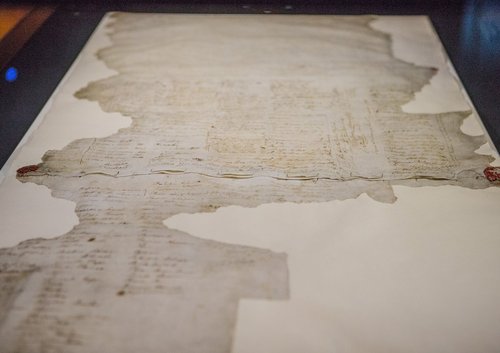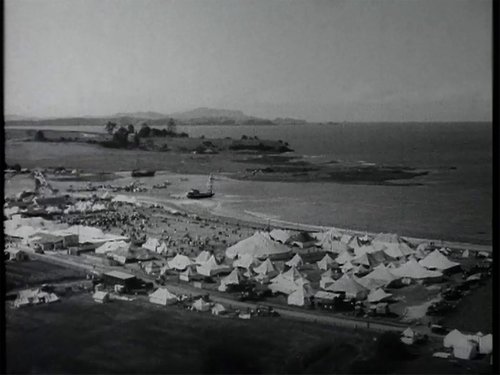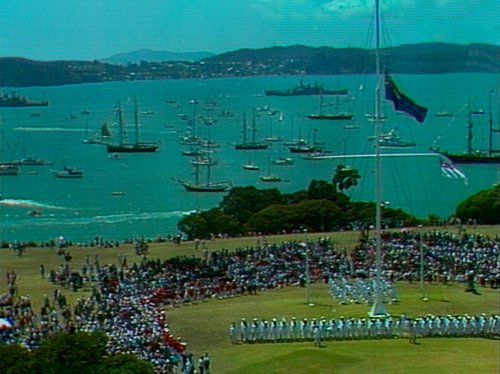
Above image: Close picture of the Treaty of Waitangi.
This year we compiled a 20-minute programme that reflects on how the signing of Te Tiriti o Waitangi has been observed, using material drawn from our audiovisual collections. We catch up with the people involved in putting the programme together and find out why they think it’s a must-watch.
E oho! ‘How New Zealanders commemorate Waitangi Day 2021’ discussion.
The first official commemoration of Waitangi Day was 1934 and, remarkably, the ceremony at Waitangi was captured on film. ‘I was really surprised,’ says Pou Ārahi Paul Meredith. ‘I hadn’t seen that footage before – it was amazing.’ It captures huge crowds gathering and the recognition of the gifting of the Treaty House and grounds to the nation by Governor-General Lord Bledisloe. The event was filmed as a Soundscenes newsreel by pioneering filmmakers Rudall Hayward, Lee Hill and Vannie Vinsen, with the recording being screened in cinemas around the country.
Short preview of 'Reflecting on Waitangi'.
Reflecting on the changes since then, Paul likes how archival material can show these developments. ‘With the early official commemorations, some of the participants were complicit in what the government was doing. Later in the 20th century, we see more public protests and activism.’ While early occasions were driven by government, Māori have had increasing agency since then. During the 1970s and 80s, the approach of Mana Motuhake and Māori activism changed from saying ‘the Treaty is a fraud’ to ‘honour the Treaty’ in a short amount of time.

Still from 'Soundscenes Newsreel – Special of Waitangi Celebrations', 1934.
Archival records can only show so much though, he notes. ‘We don’t see what’s going on behind the scenes. There were definitely things happening, discussions and arguments, even in 1934 and 1940.’ Diane McAllen, Senior Public Programmes and Partnerships Advisor, agrees. ‘This recording is such a small part of the history of Waitangi. We call the programme a reflection but it’s like a mirror or a kaleidoscope, through a narrow filter.’ Only a small part of history is ever captured in an audiovisual archive and there is lots that gets left out.
‘Waitangi and Te Tiriti isn’t just thought about on Waitangi Day: Māori think about it every day.’
Still, the collection Ngā Taonga does hold is rich and compelling and Reflecting on Waitangi is an exciting compilation. With a strong curation background, Diane worked with Paul and other colleagues to put the programme together. She then used her contacts to partner with more than a dozen libraries and public agencies to share this compilation. Libraries in particular are rich with potential for deeper engagement. ‘Lots of branches will have their own exhibit or themes they’re exploring – comprising books and their own archival photographic collections,’ Diane notes. ‘A visitor could watch the Ngā Taonga material and then read a book on display. Or they could head to our online catalogue to watch or listen to more.’ These partnerships provide opportunities for New Zealanders to connect with their history.
This connection is important. Seeing real people on screen can help us understand what it was like at the time, and to connect the contemporary with the historic. As a founding document of Aotearoa, Te Tiriti holds an ongoing significance. ‘I think it’s really important that Waitangi Day is recognised’, says Diane. ‘And anything that lets New Zealanders look into their own history and reflect on their understanding of the country is great.’

Waitangi Day 1990 - Still from Tatou Tatou, One People. (Courtesy TVNZ, TZP96820)
Everyone has a connection to something in our collections, Diane reckons – a thing they remember. One Waitangi-related event that she lived through and a title she really connects with is 1990’s Waka: The Awakening Dream. It documents how [20] waka were built and travelled to Waitangi for the 150th commemoration of the signing of the Treaty. ‘When I was a teenager my Te Reo class got to hoe te waka (paddle the waka) Te Awatea Hou around Whakatū Nelson harbour.’
Viewing very old material is amazing, but it’s important to know commemorations from today will seem remarkable in 100 years. Material in the televisions collections captures entire days’ events, both in Waitangi and, more recently, all around the country. The events we attend now and the moments we live through will become history in the future. This will present its own challenges to future archivists and audiences who may one day be asking the same question as us – how has the commemoration of Waitangi Day changed?
Despite the changes seen over the last 80-odd years of recordings, Paul knows that the conversations will continue and the thinking will evolve. ‘It’s important to keep talking, having free and frank discussions between Māori and government. The Iwi Leaders Forum is held prior to ceremonies – that didn’t happen in the past.’
And while Waitangi Day might be the most prominent day of Māori-Crown relations, Paul notes ‘Waitangi and Te Tiriti isn’t just thought about on Waitangi Day: Māori think about it every day.’